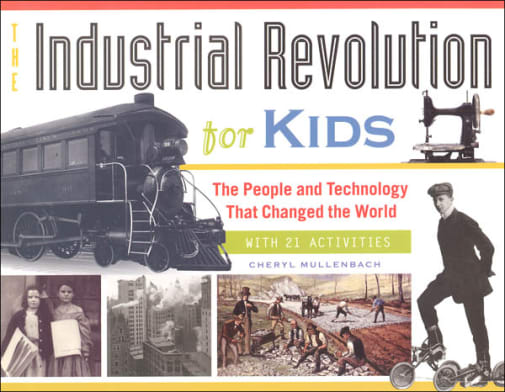Plunge into a time period characterized by dramatic change! Unprecedented change, in fact, impacting every aspect of people's lives. Technically dating from the late 1700s (first thread-spinning mill) through the early 1900s (Henry Ford's assembly line) at least for the purposes of this book the Industrial Revolution brought sweeping changes to the ways people lived and worked, bringing whole new categories of amazement (talking to one another over distance, horseless carriages) and suffering (children working in factories; mine catastrophes). Each of the six chapters in this book traces an aspect of this revolution, introduced by the real-life experiences of ordinary people, detailing inventions and the men/women who were behind them. For instance, chapter 3 describes the way people lived: the growth of cities, tenement housing, electricity and its accompanying inventions, steel production (skyscrapers), photography, cars, and department stores (a new way of shopping). As you would expect, there are short biographical sketches on key "players" such as Edison, Rockefeller, and Eastman. But there's also Nettie Shea and Eliza Trainor's story of a runaway elevator as well as 11-year-old Francis Dwyer's experience with rats in a hospital. It's these personal anecdotes that make it all so real. This book, though, is more than just stories and text. There are easy-to-do activities using everyday materials such as modeling an elevator's pulley system using Chinese carry-out containers and ribbon. Whether you have a hands-on learner who needs to try something out or a curious kid who loves the story, this book will provide an eye-opening look at a startling time period and be a welcome addition to your history studies. Pictures are black and white. 144 pgs, pb. (11" x 8.5" horizontal orientation) ~ Janice
(Publishers Description)An NCSS Notable Social Studies Trade Book for Young People ILA Children's and Young Adult's Book AwardIntermediate Nonfiction The Industrial Revolution for Kids introduces a time of monumental change in a "revolutionary" way. Learn about the new technologies and new forms of communication and transportation that impacted American lifethrough the people who invented them and the people who built, operated, and used them. In addition to wealthy industrialists such as John D. Rockefeller and Andrew Carnegie and ingenious inventors such as Eli Whitney and Alexander Graham Bell, you'll learn about everyday workers, activists, and kids. The late 19th and early 20th centuries come to life through the eyes of hardworking Chinese immigrants who built the Transcontinental Railroad; activist Isaac Myers, an African American ship caulker who became a successful businessman and labor union organizer; toiling housewife Hannah Montague, who revolutionized the clothing industry with her popular detachable collars and cuffs; and many others who help tell the human stories of the Industrial Revolution. Twenty-one hands-on activities invite young history buffs to experience life and understand the changing technologies of this important era.

